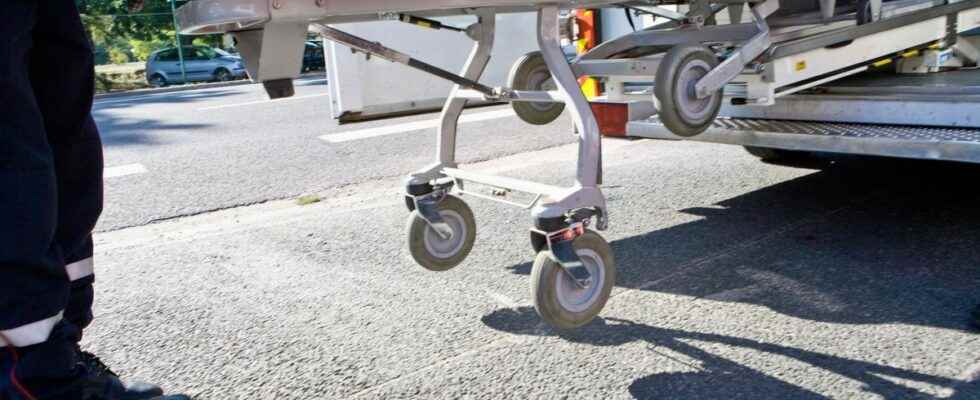Published on
Updated
Reading 3 mins.
in collaboration with
Dr Gérald Kierzek (Medical Director)
On January 24, the GHU Paris, the leading Parisian hospital for mental illnesses and the nervous system, announced the establishment of a mobile neurovascular unit, with an on-board scanner, to treat stroke victims more quickly at their place of accident. A good idea on paper, which is not unanimous and does not convince Dr. Gérald Kierzek, emergency doctor and medical director of Doctissimo.
Because every minute counts in a stroke, care must be quick and responsive, to put the odds on the side of the victim. It is with this stated aim that the GHU (Groupe Hospitalier Universitaire Paris psychiatrie & neurosciences) was enthusiastic on Tuesday January 24 by announcing on Twitter in particular, the commissioning of its first mobile neurovascular unit, with on-board scanner, in the streets of Paris. . A unit capable of starting stroke treatment, whether ischemic or hemorrhagic in nature, without waiting for hospitalization.
25 minutes saved, according to the GHU
Concretely, and according to the page dedicated to this news on the GHU website, a mobile vascular unit is a medicalized ambulance but dedicated to the management of strokes. It includes a scanner, a basic biological laboratory and a telemedicine solution. The use of the scanner on the spot would be used to distinguish with certainty hemorrhagic and ischemic stroke without waiting for the arrival at the hospital.
“It was thus shown in Berlin that the mobile UNV makes it possible to perform intravenous thrombolysis 25 minutes earlier compared to the usual management. This is considerable when we know that each minute saved to start intravenous thrombolysis corresponds to two additional days of life without disability.” evokes Guillaume Turc, neurology doctor at the GHU Paris and coordinating investigator of the project.
The project also estimates that this mobile unit would also make it possible to treat more patients, “who would have arrived too late at the hospital to receive this treatment.”
“This is not the answer to give when it comes to stroke”
The initiative is based on a reality (“every minute counts”) and has the merit of attempting a new approach to stroke management. But for Dr Gérald Kierzek, emergency physician and medical director of Doctissimo, it does not meet real and existing needs. Four points in particular raise questions:
Soon a cardio ambulance for heart attacks and angioplasty, a visceral surgery ambulance for peritonitis requiring emergency surgery, a cardiac surgery ambulance for dissections that cannot wait. Medical ineptitude and mismanagement of means to be put elsewhere.
— Dr Gérald KIERZEK⚡?⚕️ (@gkierzek) January 26, 2023
The time factor attributed to rescue
“In stroke, time is key, it’s true. But the loss of time, currently, is not on the rescue chain. It is above all in the information of the population who knows little about stroke, and the triggering of the alert” he opposes. On the contrary, on the emergency side, everything is triggered very quickly: the Samu, the firefighters know the gestures and go directly to a hospital equipped with a scanner or an MRI with a neurovascular intensive care unit, especially in Paris .
The place of intervention
There again, surprise, since the mobile vascular unit is announced… in Paris. An aberration for the doctor. “One could imagine that a scanner that comes to the patient’s bedside would be interesting, but only in the event that there is none nearby, in an area far from hospitals. What interest in Paris?
The embedded tool
The CT scan is not the standard device for diagnosing stroke. “We know that the neuro vascular units make decisions on MRI, to decide on the treatment. A scanner as on-board equipment also raises questions for me”.
The diversification of units
More broadly, the emergency physician does not see the point of designing units dedicated to the various pathologies (stroke, cardio, etc.). “It’s the opposite of the Samu model which is to diagnose pre-hospital, by sending a team to make the diagnosis and send the patient to the best place depending on his condition. Do more in pre-hospital, why not, but it should not waste our time”.
In the presence of these signs, call 15!
Whatever the future of this mobile unit, it is an opportunity to remember the right actions, whether you are a victim or a witness of these symptoms:
- A deformation of the mouth, an asymmetrical smile;
- Weakness on one side of the body;
- Speech disorders.
All accompanied by blurred vision, headaches, balance disorders: it is important to contact the Samu without delay, i.e. the 15th.
